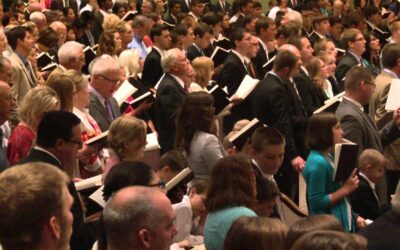The Psalms tell us over and over to “sing a new song to the Lord.” Each generation has followed this command and sang their new songs with the church of their day and shared them with the church of the generations to follow. The hymnal is the repository of the sacred song of the church sung faithfully by those who came before us. But the hymnal doesn’t contain everything created as “new songs” from previous generations. The hymnal is also filter for it retains and promotes the BEST examples of the “new songs” of previous generations while, for the most part, excluding the worst examples. If you will, the hymnal separates the sheep from the goats. But the hymnal doesn’t help us distinguish between the good and the bad of OUR generation’s “new songs.” So let me propose a series of five questions to ask as you evaluate new hymns so you can select the best new music of our generation for corporate worship.
- Is the text worthy of the corporate worship of God? Yes, there is a difference between personal and corporate worship. Choose hymn texts for corporate worship that are appropriate for corporate worship. Make sure the text matches your theology. Read through the text to determine its merit. Just because someone wrote something “from the heart” doesn’t mean it is worthy for the corporate worship of God. Evaluate the text. Does it have a rhyme scheme? Does it use proper grammar? Is it in good poetic form? Is it of theological substance? Does it avoid “vain repetition?” Does it avoid emotional hype?. The best texts will have spiritual depth, will be well-crafted poetry, and will give common voice to the congregation to offer their corporate praise to God.
- Is the melody singable? Just because a melody is popular doesn’t mean its singable. Remember, the congregation is made up mostly of untrained singers. You can’t give them something difficult to sing, even if its “catchy,” and expect them to be willing participants. The goal is to get EVERYONE to sing together. Make sure you select melodies that make sense. Use melodies that are in repetitive forms, like AABA. Melodic repetition makes learning new music so much easier. If you hear a melody once or twice and can hum it the third time it is probably a singable melody. If it’s a melody that sticks with you like an ear worm it’s probably a singable melody. Check to make sure the melody is PREDOMINANTLY stepwise movement and doesn’t jump all over the staff. But also make sure the melody fits the mood of the text!
- Is the rhythm singable? Many new hymns are composed by and for soloists. They are conceived of as solo works, not as congregational music. Rhythm that works well for congregational singing is boring for solo singing. The rhythms of many new hymns are way too complex for congregations to sing. The rhythms used in congregational singing must be simple and repetitive. Excessive syncopation, so popular in solo singing, must be avoided in congregational singing. That doesn’t mean you can’t have any syncopation. Some simple syncopation is fine. But boring is better for the rhythms used in congregational singing. Choose rhythms they can easily perform.
- Is the music in the congregation’s range? Again, most new hymns are composed as solo music rather than as congregational music. And most of the new hymns are composed to be performed by a lead singer. And, most of the time, lead singers are high voices—sopranos or tenors. Congregations, on the other hand, are mostly low voices—altos or basses. You can see the problem, I hope! This can be an easily fixed issue by simply transposing the music to a suitable key for congregational singing. But another criteria of range to consider is span. Congregational hymns should span about one octave. This doesn’t exclude a wider span, but you should be cautious of a span wider than an octave. The new hymn “In Christ Alone” is a GREAT hymn, but it has a WIDE range – an octave and a fifth – but the extension beyond the octave only occurs one time in each verse. That’s a manageable wide range.
- Does the hymn fit where you’re using it in the worship service? This is a problem I see ALL the time. A worship leader selects hymns without consideration for their placement in the worship order. Worship has 6 components. And each component is different so requires different hymns. If you’re singing a hymn of praise at the beginning of worship (and you should be) then make sure the new hymn you select is a hymn of praise. It should have a text that prescribes or describes praise to God. Again “In Christ Alone” is a GREAT new hymn. It has a worthy text. It is a singable melody. It has singable rhythms, and, for the most part, it is within a singable range. But it is NOT a hymn of praise. It is a hymn of Proclamation. It is a creedal statement. It belongs in the proclamation section of worship. Place hymns where they belong in the worship service.
These are my 5 questions but I’m sure you have more to add to the discussion. Tell me your criteria for selecting new hymns in the comment section below. We’ll compile your response and discuss them in future blot posts.
_______________
Sacred Song Consulting exists solely to help congregations refine, revitalize, and reform traditional worship for contemporary people. We are a resource for all worship leaders. We’re a guide to lead you to the best practices of traditional worship. We provide you with the tools to plan, prepare, and lead traditional worship, the nuts-and-bolts and practical concepts that help traditional worship honor God and enrich the life of the congregation. We are here to help you! You are not alone in your desire to have transformative worship in your congregation. Reach out to us. Let us know how we can help!



0 Comments